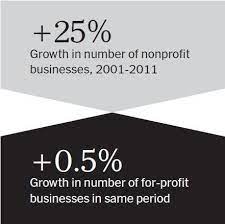Be the first one to receive latest updates.
The Multifaceted Economics of Non-Profits

In working with multiple non-profits through Treefish, I have built a lot of respect for them. They need to be operationally agile, adaptable, service minded unlike for profit organizations. Non-profit organizations play a vital role in addressing societal challenges, providing essential services, and advancing social causes. While the primary goal of non-profits is not profit maximization, they still operate within an economic framework that requires careful resource allocation and strategic decision-making. In this article, I explore the economics of non-profits through the lens of various disciplines.
Lets start with the behavioral aspects. Non-profits need to examine the biases and psychological factors that influence donor behavior, volunteer participation, and the effectiveness of charitable interventions. Understanding these behavioral dynamics helps non-profits design more effective fundraising campaigns and tailor their interventions to maximize impact.
Non-profits often operate in developing countries, where they address issues such as poverty, education, healthcare, and economic development. They often operate across borders, engaging in international aid, disaster relief, and development projects. They need to analyze the impact of their initiatives on long-term growth, poverty reduction, and human well-being. By studying the economic, social, and institutional factors affecting these regions, non-profits can develop sustainable strategies to promote development and social progress. They need insights into trade, foreign aid, exchange rates, and global economic interdependencies. They can leverage this knowledge to enhance their cross-border collaborations, navigate regulatory frameworks, and address the economic challenges faced by marginalized communities worldwide.
Another critical aspect is that non-profits need to measure the effectiveness of their programs and quantify their impact on the target population. Through the use of statistical tools and data analysis, non-profits can assess program outcomes, identify causal relationships, and make evidence-based decisions. They also need to closely track the cost-effectiveness of different interventions, allowing them to allocate their resources efficiently.
Non-profits face unique financial challenges, including fundraising, managing endowments, and ensuring long-term sustainability. They need to optimize investment strategies, manage risk, and make prudent financial decisions. Understanding asset allocation, portfolio management, and fundraising can enhance the financial stability and resilience of these organizations.
In addition, non-profits need to analyze competition, pricing strategies, and market entry barriers. This will help them identify niches, understand the competitive landscape, and optimize their service delivery. This is particularly relevant for education and healthcare non-profits.
Non-profits rely heavily on a committed workforce, including employees and volunteers. They need to understand the motivations, incentives, and compensation structures that drive individuals to work in the non-profit sector. Attract and retain talent is a challenge for non-profits since compensation is much lower. However the reward is in personal satisfaction.
Non-profit organizations encompass a broad range of economic disciplines that they need to navigate to optimize their resource allocation, and maximize their societal impact.
Leave a Comment Cancel Reply
Search
Archives
- March 2024 (3)
- February 2024 (6)
- December 2023 (4)
- November 2023 (6)
- October 2023 (4)
- September 2023 (4)
- August 2023 (8)
- July 2023 (7)
- May 2023 (7)
- April 2023 (3)
- March 2023 (7)
- February 2023 (7)
- January 2023 (9)
- December 2022 (8)
- November 2022 (3)
- October 2022 (7)
- September 2022 (10)
- July 2022 (2)
- June 2022 (3)
- May 2022 (16)
- April 2022 (8)
- March 2022 (11)
- February 2022 (3)
- January 2022 (10)
- December 2021 (3)
- November 2021 (5)
- October 2021 (4)
- September 2021 (2)
- August 2021 (4)
- June 2021 (1)
- May 2021 (4)
- April 2021 (4)
- March 2021 (2)
- February 2021 (1)
- January 2021 (1)
- December 2020 (4)
- November 2020 (9)
- October 2020 (4)
Categories
Recent Posts
Recent User Posts
- admin on Most popular volunteer opportunities
- Jennifer Brown on Volunteer with the US Geological Survey and make maps accurate
- Ariana Huerta on Most popular volunteer opportunities
- Neda davari on Make holiday and New Year themed cards for isolated, older adults
- Daniela on Teach English 1 hr per week

2 Comments
Hansika
July 2, 2023Pls let me know how can I help in this nonprofit organization , I would like to do service in technologies and tutoring writing essays, etc pls let me know the details
admin
July 2, 2023Please apply directly to them